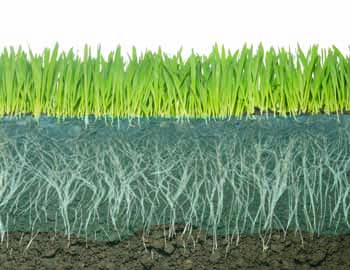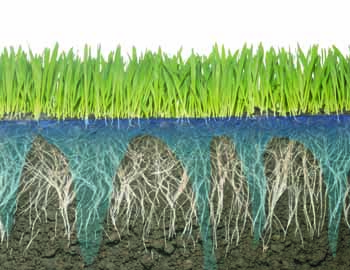Managing water with soil surfactants
What is a wetting agent / surfactant and why are they so useful at dealing with golf course water management issues such as dry patch, which can have a profound effect on surface performance? Here, Aquatrols provides the answers.
The dry start to 2021 has ensured that water management is at the forefront of the mind of turf managers everywhere. But what does it really mean? To fully understand the benefits of a programmed approach to water management, it is a good idea to go back to basics and first understand about water itself, why it behaves like it does and what tools are available to ensure a successful and stress-free season.
The chemical formula for water is H20, which tells us that one molecule of water is made up of two hydrogen atoms and one oxygen atom. H2O is neutral, meaning it carries no net charge. However, it is a strongly polar molecule in that it carries a partial positive charge near the hydrogen atoms at one end and a partial negative charge near the oxygen atoms at the other. As you know, opposites attract, and it is this attraction that allows water molecules to interact with each other and other surfaces.

Wetting agents help overcome repellency issues so that water moves uniformly throughout the soil profile, supporting healthier turf
There two primary forces at play with regards to water are cohesion and adhesion. Cohesion is the force which causes water molecules to be attracted to each other; it reduces the surface area and is the reason that water forms droplets. Adhesion is the attraction of water to other surfaces; it reduces surface tension to allow water to spread across a surface. We see cohesion and adhesion happening all around us in our daily lives. For example, when a dragonfly lands on a pond it is the force of cohesion pulling water molecules together and creating surface tension that allows it to walk on the water’s surface. When we are stuck indoors on a rainy day and water droplets are running down the windowpane, it is adhesion that allows the droplets to stick to the surface of the glass.
To create a uniform and consistent wetting front in the soil profile it is important to understand how these two forces affect the behaviour of water in soils. One of the most common water management issues on the golf course is dry patch, where soil particles have become hydrophobic, or water repellent. Hydrophobicity occurs when soil particles become coated in a waxy residue, often the result of activity from microbes and organic matter. This coating disrupts water’s ability to adhere to the soil particles, keeping it from moving into and through the soil profile effectively. Cohesion then becomes the stronger force, allowing water molecules to cling tightly to each other in larger droplets that have difficulty penetrating the soil surface and/or are pulled unevenly through the profile by gravity.

Water repellency can cause water to move unevenly through the soil profile, channelling water past turf roots
Whether you refer to them as wetting agents, wetters, penetrants or surfactants, they all have the same function – to correct water repellency issues by restoring the balance between cohesive and adhesive forces in the soil profile. A surfactant molecule is cleverly engineered to have both a hydrophobic part (water repellent) and a hydrophilic part (water loving). The hydrophobic part attaches itself to the hydrophobic coatings on the soil particles and the hydrophilic part attaches to the water molecule, acting as a bridge between the two so that water can once again move through the profile more uniformly.
When choosing a surfactant there is more to consider than simply overcoming water repellency. The main reason we are all preparing golf courses is to create the best performing surfaces possible with the resources available to us while of course ensuring that plant health is optimum. Surfactants are not only key in managing your water but can have a significant positive impact on your root depth, grass species composition, surface firmness and ultimately surface performance such as speed and trueness. Choosing the wrong surfactant technology can very easily create soft, holding surfaces which are shallow rooted and prone to disease attacks. Conversely, choosing the right technology for your site can ensure that you have healthy, firm surfaces which do not suffer from the effects of stress created by dry conditions.
Aquatrols specialises in soil surfactant technologies, having developed and introduced the world’s first soil surfactant in 1955. Since then, we have pioneered the innovation of new technologies and are passionate about helping all turf managers overcome their water management challenges and promote strong, healthy turf. We all have the same end goal – to create the perfect surface for the perfect game. The right surfactant can play a pivotal role in achieving that goal. The Aquatrols technical field team would love to be part of that journey on your course. If you feel that we could help, please get in touch with your Aquatrols territory manager.
For more information, visit eu.aquatrols.com















Let me tell You a sad story ! There are no comments yet, but You can be first one to comment this article.
Write a comment